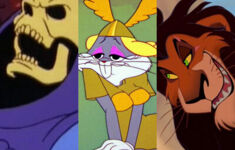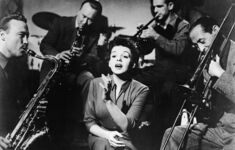Judy Garland gave one of her best performances in… an animated musical about a gay cat in Paris?


Welcome back to our queer film retrospective, “A Gay Old Time.” In this week’s column, we revisit Gay Purr-ee, an oft-forgotten animated musical featuring the voice of the original gay icon, Judy Garland.
As we have discussed many times before in this column, queer content and representation on films in the early part of last century was often sparse, hidden, or coded. We’ve had to dig for hinted-at relationships and character backstories, read into the mannerisms of the villains and sidekicks, and find resonance in themes rather than in explicit stories. Almost all of this representation (coded or otherwise) happened in adult, live-action films.
So this week we decided to ask, had there been any traces of queer themes in an animated movie from that era?
It’s not until quite recently (in the last decade or so) that mainstream animated family movies have started being overt about including LGBTQ+ characters and storylines, even if they often feel like scraps or second-rate moments that can easily be edited out for foreign markets. These are your “exclusively gay Disney moments,” your blink-and-you-miss-it lesbian mothers in the background, your mention of a same-sex partner that is said almost under the breath. But had there been something before all this?
Enter the 1962 film Gay Purr-ee...
The Set-Up
Did we stumble upon this movie by accident, by entering “gay animated movie 1960s” into a search finder? Maybe so! But even if it was unintentionally, here was this underseen, under-discussed hidden gem of animated musicals; the first animated theatrical release by Warner Bros. about a cat that escapes the French countryside in pursuit of the glamor and fine living of 1890s Paris.
There, she discovers that the City of Lights is more dangerous and scarier than she expected. Oh, and this cat is voiced by none other than thee Judy Garland, in her only voiceover performance. So, yes, this was a movie worth discussing for our purposes.
The story is pretty simple and straight-forward, as most family-oriented movies tend to be. Longing for something bigger and better than her rural existence offers her, beautiful Mewsette (this film has a field day with cat puns) escapes to Paris, leaving behind her suitor, an orange tabby cat named Jaune Tom (Robert Goulet) and his sidekick Robespierre (Bed Buttons), a small but mighty kitten.
As soon as she arrives in Paris, Mewsette is lured and seduced by a malicious tuxedo cat named Meowrice (Paul Frees), who puts her under the care of Madame Rubens-Chatte (Hermione Gold). She runs an establishment that turns stray cats into companions. Unbeknownst to Mewsette, Meowrice has sold her as a bride and is planning on shipping her to America. It is up to Jaune Tom and Robespierre to navigate the dangerous Parisian streets and bring her back to safety.
Real Work Of Art
The film deals with some unexpectedly adult and mature themes, although most of these would most likely go over the head of a child. Madame Ruben-Chatte’s is not unlike a brothel, and Meowrice is basically engaging in human (or rather, animal) trafficking. But it’s actually quite charming in its portrayal of the fish-out-of-water story that is a benchmark for animated movies before and after. The two biggest assets that make the movie stand out and worth seeking out are Judy Garland herself (of course) and its original and audacious style of animation.
In an era where Disney was going through a Golden Age with movies like Cinderella, Sleeping Beauty, and Alice In Wonderland—all of which showcase a very traditional animation style—Gay-Purree manages to create a visual language and style that’s completely unlike anything that was done at the time.
The characters feel like elongated sketches and figures (something like what a child would draw), and the film often goes into abstract and almost psychedelic sequences of color, figures, and music swirling together. Its depiction of Paris and its streets, buildings, and alleyways is simultaneously scary, imposing, magical, and romantic.
In what is perhaps the best sequence of the movie (seen above), Meowrice is writing to Mewsette’s husband-to-be to let him know that he had all the artists of the time paint portraits of her. As he describes the artists (which include everyone from Monet, Toulouse-Lautrec and Seurat, to van Gogh, Renoir, and Picasso), the animation style of the movie changes to mirror that of the artists. Mewsette transforms into dozens of different iterations of herself in a matter of minutes. In many ways, this makes the movie more of an animation achievement, showcasing the immense talent of the production (and the fun they had making this!) above any story or character elements.
Related:
A Good Judy
And then there’s Judy. Apart from the title, the most direct connection to our community. As mentioned, Gay Purr-ee was her only voiceover role in her career, but it’s remarkable how at home she feels in it, and how she’s able to command the screen even if she’s technically not on it. Her signature voice fits Mewsette perfectly, showcasing naiveté, fear, wonder, and infatuation.
The film is a musical (these sequences are the strongest part, elevated by the eclectic images that accompany the song), and Judy’s singing elevates the melodies to a different level. Har rendition of “Take My Hand, Paree” bookmarks the film, and it is perfectly evocative of the time period, the feelings that the movie tries to arise, and a testament to the timelessness of her voice.
Très Chic

So, Gay Purr-ee is not explicitly gay, or even really very much covertly so. There are no LGBTQ+ or queer-coded characters (even though Meowrice has some… dainty mannerisms), or any elements in the story. However, it’s hard not to be completely charmed and won over by it.
If anything, it’s a forgotten gem and a genuinely great footnote in the career of one of the greatest of all time, who lets us see her in a form that she never did before or after. And just for that, it makes for a worthy entry into the canon of queer film.
Available for digital rental or purchase via Amazon Prime Video, AppleTV, Google Play, Vudu, and YouTube TV.
Related:






